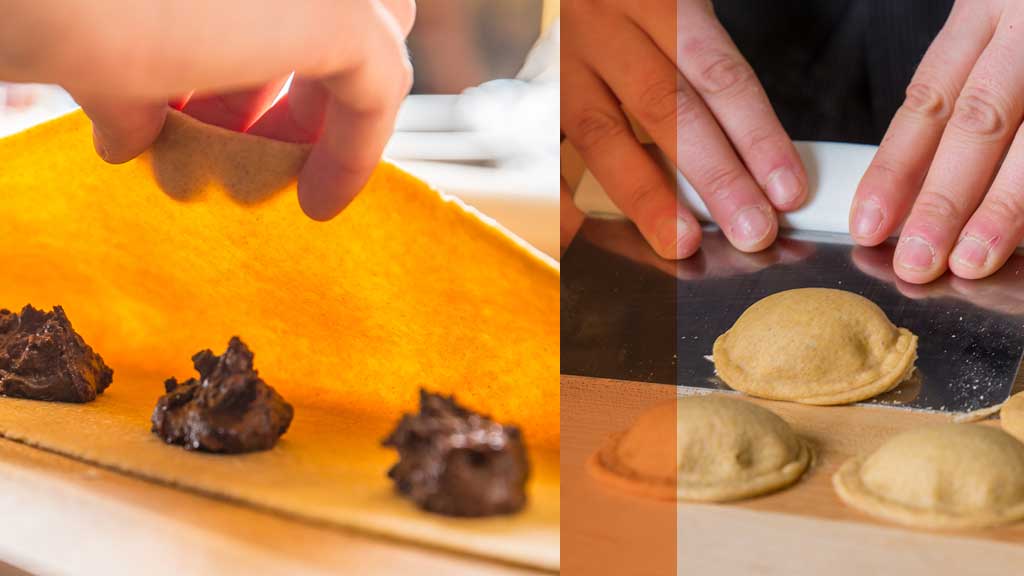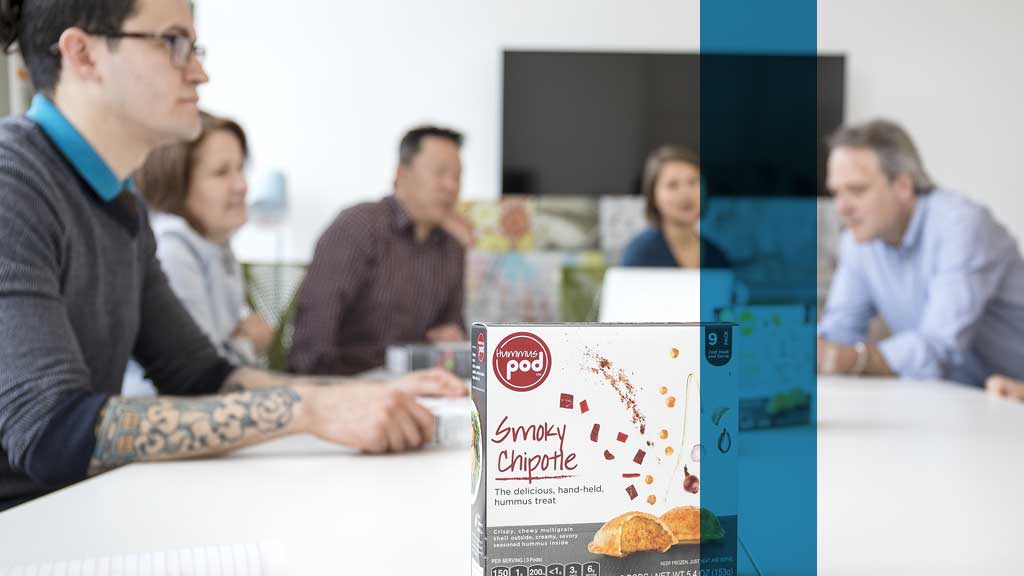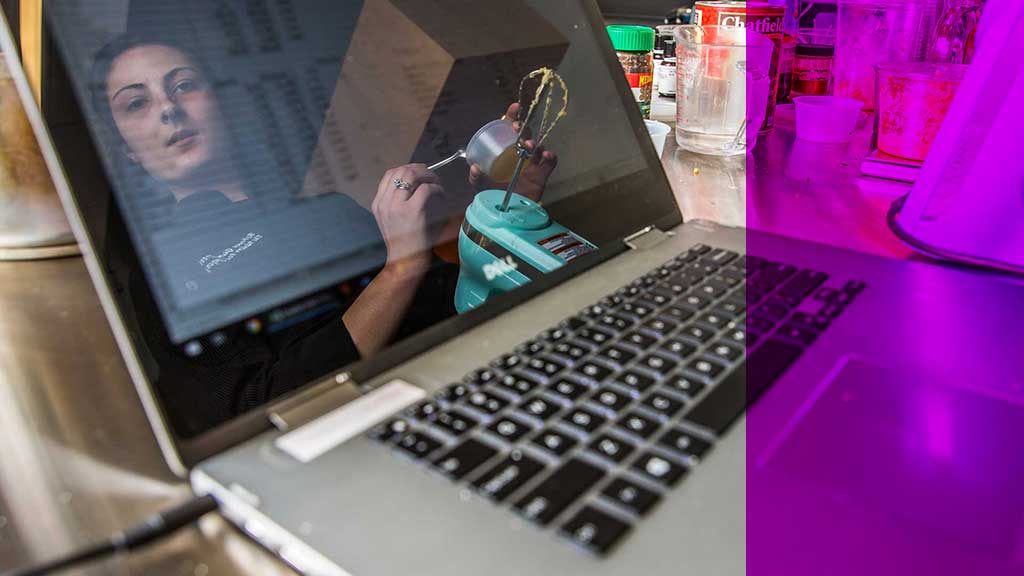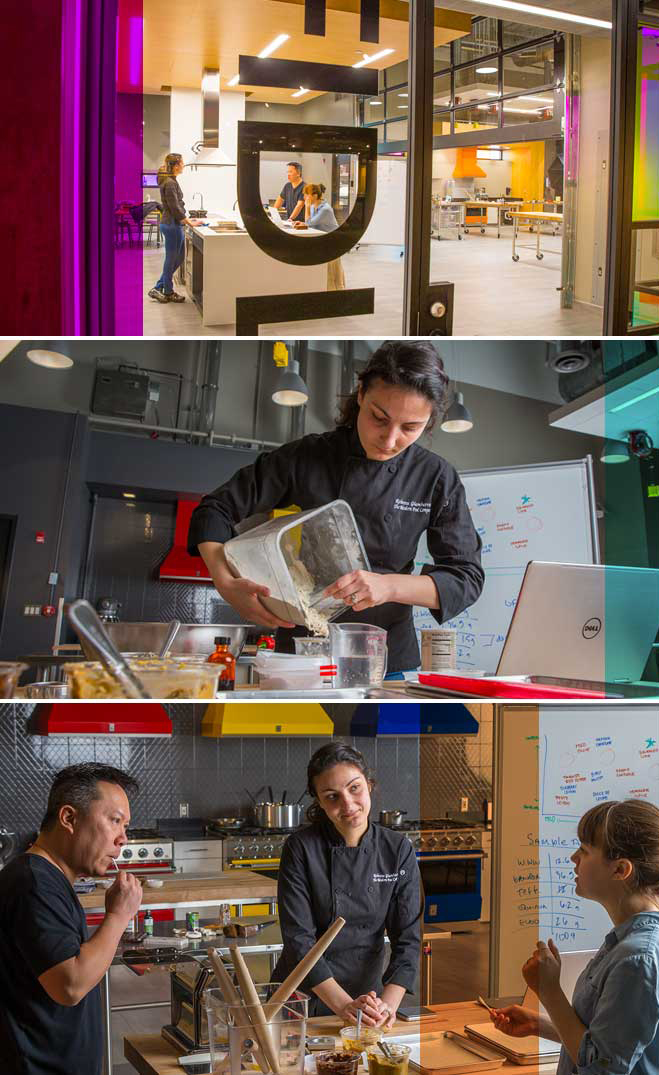From its parking lot, 63 Baker Street doesn’t look remarkable. Its only features are a flat stucco façade and broad windows with partially-raised blinds, each framing a collection of houseplants and used coffee mugs inside the glass. It’s a dead ringer for countless other anonymous office buildings around Providence — but inside its doors, something extraordinary is happening.
Baker Street is home to the Food Innovation Nexus, or FIX, a startup funded and fueled by Johnson & Wales and run by an unusual team of chefs, entrepreneurs, food scientists, product developers and designers. Together, they’re crafting revolutionary new directions for the food industry, starting in areas as diverse as hospital cuisine, frozen snack food and edible pharmaceuticals — using food itself as a drug delivery system.
“The goal of JWU and the FIX is to map the future of food; to explore a deep ocean that sits at the intersection of food, society, medicine and health,” says Co-Founder Michael K. Allio. “Here in Providence, we have amazing culinary expertise. We have deep resources in the biotech, pharma, design and health industries. We have entrepreneurs moving here daily. We want to use all those assets to create something new and innovative.”

This interdisciplinary approach isn’t exactly common in the food world. Thanks to a partnership with Johnson & Wales, however, that may soon change. The university helped co-found the FIX in 2014 as a departure from its usual kitchen-based curriculum. Now, it’s parlaying ideas hatched at the startup to develop new areas for academic study, while giving students access to real-world business ventures.
In that sense, says JWU Chancellor Mim L. Runey, LP.D., the FIX forms the innovation side of the university’s new focus on food, and will work in concert with the new JWU College of Food Innovation & Technology (CFIT), which launches in fall 2020.
“Employers want these bright and talented graduates to accelerate innovation — to create the future,” Runey says. “My vision for CFIT is to arm our students with the multidisciplinary perspective, skills and tools they need to impact the world.”
BOSTON CHILDREN’S HOSPITAL
Staff members at the FIX have already begun to take on those sorts of challenges at the famed Boston Children’s Hospital. Four years ago, the hospital revamped its food court, transforming it into a place where culinary staff can interact with patients and families. The space is now airy and comfortable, with long curving walls and soft lighting. In one section, a semicircular open kitchen is manned by chefs in tall white hats, and a central food prep station hosts cooking classes and demonstrations.
As food courts go, it’s downright homey, and for good reason. Its goal is not only to serve healthy, nurturing food, but to provide a nurturing environment for meals — a welcome resource for patients and families going through long-term treatments. The only catch, according to Shawn Goldrick ’96, is that those patients make up just a small percentage of kids seeking treatment at the hospital — there are thousands more who don’t have time for a full sit-down meal.
“We have more than 4,000 ambulatory visits a day,” says Goldrick, the hospital’s patient support services director, who oversees its culinary staff. “There are a lot of families coming in for an hour-long appointment with their child and then going home. They may not have time to take advantage of the healthy, plant-based meals we’re developing, no matter how good they are.”
On a Monday morning, that’s abundantly clear. A long line of bleary-eyed parents, kids in wheelchairs and harried staff members are streaming through the front doors, crowding a Starbucks before running off to appointments. Goldrick gestures in their direction.
“We have some amenities for those sorts of visitors, but the food they can grab and take with them is pretty limited. We wanted to partner with JWU and the FIX to help provide the same nutritious diets we offer in the food court, but in a form that people can use as a meal replacement wherever they go.”
There’s an additional twist, he adds: The hospital plans to replace an existing restaurant stand with these new delicious “better for you” healthy offerings, without retrofitting the space with stoves or other open-flame appliances.
To meet these challenges, FIX staff worked with JWU faculty and students to develop a food experience with broad cross-cultural appeal (more than 30 percent of patients are foreign visitors, Goldrick notes) — one that could be eaten easily on the run, and prepared using nothing more than an electric oven.
“Our research into patient and family needs, plant-based food trends and the physical space parameters ultimately led us to hand pies as a form factor,” says Allio. “Every culture has one. They’re familiar, comforting, and they can deliver a variety of healthy fillings.” To be successful at the hospital, though, they’ll also need to be large enough to satisfy, resist getting soggy after time, be sturdy enough to hold their shape when halfway eaten, and yet still be delicious.
Hitting all those targets is tougher than you might think, says T.J. Delle Donne ’04, ’07 M.A.T., associate instructor and assistant dean of culinary relations and special projects at JWU. He was part of a faculty team that developed entirely new types of dough and fillings for the pies, while exploring a range of global culinary influences.
“Everything on the food side of this project was developed at JWU with the help of our students: the ins and outs of how the pies are made, the flavors, sauces, side, dishes, drinks and so on,” says Delle Donne. “But the FIX brought our work to the next level by tackling the business elements of the product and designing how customers will actually experience the food. That was huge.”
The FIX’s new hand pies may be in the Boston Children’s Hospital food court by the end of this year, as the centerpiece of a dramatic new restaurant format. But another FIX project that deeply influenced that work is already commercially available at more than 2,000 grocery stores nationwide. They’re Hummus Pods— small, dumpling-like pitas pre-filled with creamy hummus. Like the hand pies, they’re plant-based, easily portable, convenient, delicious and healthy, says Delle Donne, who — with a team from JWU — was intimately involved in their development.
“Hummus turned out to be a perfect product,” says Delle Donne. “It contains a good amount of olive oil, which has lots of known health benefits, and it’s already part of a billion-dollar market.”

When the FIX team challenged Delle Donne to develop a new spin in 2014, he enlisted the help of (then) students Luis Rivera ’15 and Rebecca (Giambarresi) McCartin ’15, and spent months at a time working on new ideas and formats.
“One version looked almost like a cannoli, with hummus piped into a pita shell,” he recalls. “Another had a lining of fruit leather to keep the pita from getting soggy. I think we worked eight months to perfect the dough alone.”
As with the hand pies, adds Allio, the key to bringing Hummus Pods to market was not only constant experimentation, but the ability to bring multiple disciplines together to collaborate successfully on the project. “We had product designers talking to Generation Z students talking to production engineers and culinary folks, all working to fine-tune the product. We had to collaborate with manufacturers to adapt tools and equipment, and even bring in process innovations from other industries to make them with consistent quality at commercial scale.”
Today, the FIX has secured several patents for the Hummus Pods and is already shipping them to major grocery chains like Whole Foods and Kroger, coast to coast.

DANTE’S EIGHTH CIRCLE
The innovations coming out of the FIX go far beyond just healthy snacks, however. The company is also developing and launching foods that can be used as medications themselves — essentially making drugs in edible forms that are more appealing to patients.
“People get sick of taking pills and mixing powders. But everyone is comfortable and familiar with eating — so why not combine the two?” asks Corey Siegel, a gastroenterologist at Dartmouth College. “If you have a drug embedded in food, or food as drug itself, it’s not hard to get consumers onboard.”
In some cases, he says, making drugs more palatable could mean the difference between life and death. Colon cancer, one of the most common causes of cancer death in the U.S. today, can often be treated successfully if it’s caught in its early stages, yet millions of Americans don’t go through with routine colonoscopy screenings. More often than not, Siegel says, that’s because of the unpleasant drugs they’d need to take beforehand.
If you haven’t yet experienced that unique joy, just know that it involves fasting for at least 24 hours, choking down a gallon of thick, salty liquid, and spending a disproportionate amount of time in your own bathroom. It could easily be Dante’s eighth circle of hell.
“Every single patient tells us how miserable they were taking medications for colonoscopy prep,” Siegel adds emphatically.
He and his business partner, gastroenterologist Josh Korzenik, are working with the FIX to develop products that make colonoscopies easier to bear. Instead of forcing patients to avoid food entirely, the group has invented snacks that taste good, yet also contain polyethylene glycol, the drug that clears out patients’ intestinal tracts. In doing so, they solve two problems at once: staving off hunger during colonoscopy prep and doing away with the need to drink copious amounts of salty goop.
But making polyethylene glycol appetizing is a tall order, made even more difficult by a few regulatory details. To get this approach cleared by the FDA, the team has to make the products using only substances that appear on a list of pre-approved drug ingredients, and prove that they’re safe and effective.

“You can’t just reach for the spice rack,” says Allio. “Natural ingredients vary a bit in their nutritional content from batch to batch. If you’re making a drug, it has to deliver the exact same thing, every time, without fail.”
The resulting process is a bit like making an elaborate dessert using only items from your medicine chest — the sugar that coats painkillers; the cherry flavoring found in cough syrup, and so on. Creating foods that are actually palatable from those isn’t easy. “We had a few flavor misadventures along the way,” Allio says with a grin. “But let’s just say that there’s some magic in FDA-approved cocoa butter.”
Back at the FIX offices, he shows off the end result: a slim cardboard box covered in colorcoded geometric designs. Inside, six bar-like snacks nestle against one another. They have a dense, pale matte surface, almost like Japanese mochi rice cakes.
Although they look appetizing, he’s quick to remind me that these aren’t really foods at all. They’re technically drugs that patients “take” at pre-prescribed times — one for breakfast, lunch, an afternoon snack. Compared to the usual thick liquids, though, they’re infinitely more appealing. Colonoscopy patients seem to think so as well: the bars are already being validated in human clinical trials with success.
That’s exactly the goal that Seigel and Korzenik set out to achieve. The pair partnered with the FIX to start a new company called Colonary Concepts, which is developing the formulations and partnering with larger pharmaceutical companies to commercialize.
They and their partners are also working with the FIX on the next array of similar food-plus-medicine products, focusing on chronic constipation and other ailments.
“The FIX has a broad range of expertise that really appealed to us,” says Siegel. “We needed the sort of multidisciplinary approach they took — not just figuring out the business side, but the food science side, the marketing side, the design and manufacturing side. Everyone else we talked to could do one of those things, but FIX was the first to see 360 degrees on it.”
THE FOOD INNOVATION DESIGN LAB
JWU’s philosophy of combining multiple disciplines is also appealing to a growing number of students and graduates. Rivera and McCartin, who helped develop Hummus Pods during their junior and senior years, now work there full-time as product developers, researching, testing and marketing new product ideas for the company.
As the pair walk through the university’s culinary museum, they point out past food innovations like antique hot dog bun-making machines and early “radar ranges” (a.k.a microwave ovens). They turn a corner, pass a full-sized exhibit of a chrome-covered train car diner, and enter the gleaming new kitchen and test facility — JWU’s Food Innovation Design Lab.
“It’s really exciting that the work we’re doing might give future students opportunities that we may not have had as undergraduates,” McCartin adds, gesturing at the CFIT space as JWU staff unpack boxes and assemble metal prep tables behind her. “They’ll have this beautiful design space, and the culinary and creative freedom to start thinking about food differently, including more applied techniques for product development.”

Rivera nods in agreement. “Students at JWU have not traditionally been taught to have conceptual ideas about food,” he says, “Like, how would you deliver the nutritional benefits of lycopene from tomatoes to a client? You’d normally be taught to just make a great dish or food product. But if you start thinking about it chemically, it’s also fat-soluble, which means you could deliver it through the skin. You could put it in a topical cream. You could make it an ingestible that would absorb through the roof of the mouth or stomach lining, so you don’t need to digest it all the way. Thinking about it that way is sort of the ultimate deconstruction of food.”
This is the sort of mindset that the university aims to teach through both its collaboration with the FIX and its new academic enterprise at CFIT — not just introducing new ways to approach food, but instilling in students a sort of culinary philosophy that’s fluid and open to innovation. “We want JWU to train the next generation of innovators who marry disciplines together,” says Allio. “At the FIX, our dog in that hunt will be to turn their solutions into products for more people to take advantage of them. JWU has the world’s experts on food prep, delivery and handling. It’s increasingly strong in science and engineering. So what’s the convergence of these? Let’s let the next generation of students train not just as cooks, but as nutrition scientists, or occupational therapists that understand the link between food, nutrition and medicine. That’s the future we’d like to create.”